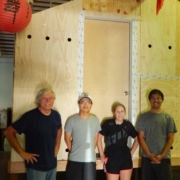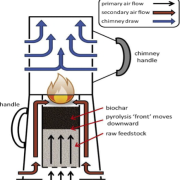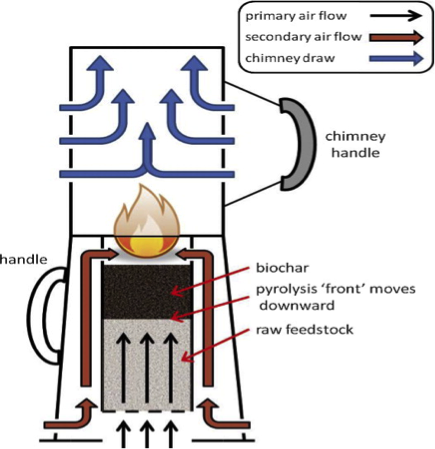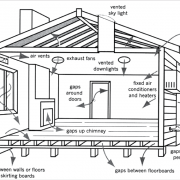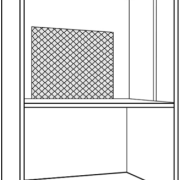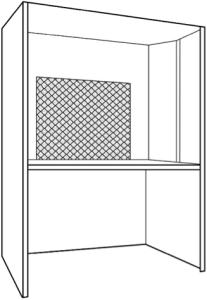Watch Integrated Stove Video
/2 Comments/in Heating Stove, Rocket StovesIntegrated stove for heating, cooking, electricity
Watch a video of the downdraft rocket stove that ASAT Inc. will show in Washington D.C. at the Alliance for Green Heat/DOE sponsored Wood Stove Design Challenge from Nov 9 to 13. ASAT gratefully acknowledges support from the US Environmental Protection Agency under EPA SBIR contract number EPD18009.

See an introduction to the Integrated Stove on Youtube: https://youtu.be/LUH3LMTG1OM
Long sticks are placed vertically in the combustion chamber where only the tips burn. A weight pushes the wood down as the ends turn into soft charcoal. Cooling fins on the top half of the feed tube help keep only the tips of the sticks burning. The room air is heated by the tall heat exchanger and cooking is possible on top of the cylinder.
The stove features a thermoelectric generator near the coals to create 18 W of electricity when the stove is running at its 10 kW high power setting. The electricity is distributed to two USB ports for high speed cell phone charging and LED lighting. Aluminum fins protrude into the combustion chamber to bring heat to the hot side of the generator, and a radiator on the bottom of the stove draws the heat away from the cold side and into the room.
It has been quite nice to have a warm lab as the temperature outside drops. You will certainly enjoy it during our post ETHOS TLUD summit.
Smoke Distributions in a Test Kitchen
/0 Comments/in Indoor Air QualityARC has built and used two Test Kitchens and now, has by far the best one, built by Andy McClean and the three summer interns. We are looking at the distribution of smoke and the effect of opening doors and windows. Past tests with the early test kitchens showed that smoke stratified by height with the highest concentrations near the ceiling. Makes sense to cook near the floor! Opening the door dramatically lowered both PM and CO. (See: Test Results of Cook Stove Performance, page 68)

The new Test Kitchen is a bit of an improvement. It has a volume of 30 cubic meters and the air exchange rate is controlled by 48 electric fans that are evenly spaced around the top perimeter of the building. Openings (48) along the bottom perimeter let dilution air in the test kitchen.
For the first experiment in the test kitchen the air exchange rate was determined using the tracer gas decay method (CO from a charcoal stove). The speed of the fans was adjusted until 15 ACH was measured. The smoke distribution while conducting water boiling tests was measured using 30 light scattering based PM detectors (HAPEx) that were hung from the ceiling and evenly spaced throughout the volume. The emissions rate of the rocket stove was measured using an ARC PEMS that was fitted with a partial capture probe and a gravimetric system for measuring PM2.5 (new development!). The gravimetric measurement of PM2.5 was used to calibrate the HAPEx. The tester fed the fire from an opening in the side of the test kitchen so as not to be exposed to the smoke from the fire. The test kitchen was built inside a large barn that had a fan-controlled cross ventilation. The background smoke concentration was recorded during the tests.
Results from the preliminary analysis show that there was vertical stratification, that the smoke in the room was evenly mixed from side to side, and that the average room concentration was similar to that predicted by a single zone box model. Stay tuned for more results!
Patterns for Combustion Chambers
/2 Comments/in Cleaner Burning TechnologiesIf wood gas passes into flame, it can ignite and less un-combusted smoke escapes. Which of the following patterns has the greatest potential for clean burning? Maybe “the devil is in the details”?
- The pattern that Dr. Winiarski often tries is downdraft/down feed. The wood is burned at the bottom of a vertical stick that can fall down as it is consumed. Air is pulled down alongside the sticks and into the fire. The charcoal falls below the sticks and in front of the flame path as flame is pulled horizontally into an insulated space by the draft in the Rocket short chimney.
- Side feed/side draft is how most people feed a fire. The sticks are pushed into the fire as they burn. In this pattern, the fire creates charcoal that lies underneath the burning sticks of wood and helps to keep the fire going. When the tips of the sticks burn combustion is fairly clean. The sticks and fire are directly under the short chimney in the Rocket stove and the flame is pulled up towards the pot.
- Top Lighting a batch of fuel. Sticks, for example, are loaded vertically, packed fairly tightly and hold each other up in a crucible. The entire top of the fuel bed in lit and is on fire. The fire slowly travels down into the crucible. The wood gas rises and enters the fire from below.
If you wanted to minimize escaping smoke would you light the fire on the bottom or side or top of the sticks?
If the wood sticks are lit on the sides or on the bottoms the wood gas must be forced by the stove to join into the fire. Lighting the entire top of the batch of fuel has the natural advantage that all wood gas passes into flame. Masonry heating stoves have often used this top burning technique to clean up combustion. In each case the same principle applies: 1.) All the wood gas must go into the hot flames and 2.) Be well mixed there with air 3.) For a long enough time for complete combustion to occur.
Diagram of Top Lit UpDraft Stove (TLUD)
Testing in the laboratory and in the field
/2 Comments/in UncategorizedTesting in the laboratory and in the field
It is important to remember that in the Aprovecho lab, the 3 Stone Fire has used less wood and made less pollution than cooking fires and high mass stoves operated by cooks in the field. The fires in the lab tests were carefully made using dry and uniform sticks of Douglas fir fed into the fire in a controlled way to optimize the performance. Well-constructed 3 Stone Fires protected from wind and tended with care scored between 20% and 30% thermal efficiency.
Open fires made with moister wood and operated with less protection from the wind can score as low as 5%. The operator and the conditions of use largely determine the effectiveness of operation. Stoves have to be tested with careful repetition in order to achieve statistical confidence in the results. Because there are so many differences between laboratory and field results, it is difficult to use the results of laboratory testing to predict exactly how stoves will perform in the real world.
However, side-by-side comparisons can be used to generally estimate performance. An automobile that gets 40 miles per gallon on a dynamometer is more likely to use less gas driving down the highway than a car that only gets 20 miles per gallon in the same test. A cooking stove that used less fuel or made less pollution in a standardized test will, one hopes, translate into reductions in the field, but field surveys are needed to establish the actual performance. Field tests are essential to also learn lots of important things, such as if the cook likes the stove, whether the stove product will be successful in the market, and how much PM2.5 and CO is inhaled by members of the household.
In our opinion, no lab test can replace going into the field and learning from reality. And, being taught about stoves from cooks is one of the most fun parts of this job.
Happy Holidays Clean Combustion Techniques
/0 Comments/in Cleaner Burning TechnologiesHappy Holidays Clean Combustion Techniques
1.) When wood is burned a lot of smoke is produced but the made charcoal at the tip of the wooden stick contributes heat but does not make much smoke. Rocket Stove: Increase the time that the charcoal at the tip is burning. TLUD: A layer of hot charcoal covers the fresh wood.
2.) If the stove begins smoking the rate of reaction (solid turning into gas) is probably too fast. Too much wood gas is being produced and un-combusted fuel is escaping. Rocket Stove: Pull the sticks back until just the tips are burning. TLUD: Reduce the primary air.
3.) Mixing the smoke, gases, flame, and air can reduce emissions dramatically. Rocket Stove and TLUD: Cut up the laminar flames with natural draft mixing devices. When using secondary air increase the draft until fast moving jets completely cover the top of the burning fuel.
4.) Create a space filled with fire that forces the smoke, gases, flame, and air to mix more completely. Rocket and TLUD: Orifices successfully increase mixing.
5.) Increase the dwell time to improve combustion efficiency. Rocket and TLUD: Do not make the mixing chamber above the fire too short. With sufficient draft install fixed fan blades to induce swirl that makes at least two revolutions.
6.) Secondary air more effectively enters flame when the pressure difference is assisting the mixing process. Rocket and TLUD: In natural draft stoves the pressure is lower in fast moving flame. Add higher pressure secondary air downstream of the mixing device.
HEPA home furnace filter reduces PM2.5 emissions
/0 Comments/in Cleaner Burning TechnologiesHEPA home furnace filter reduces PM2.5 emissions
There are a number of methods to reduce personal exposure to household air pollution associated with using biomass fuel for the daily cooking and heating taking place in nearly 40% of global households. These most commonly include 1.) Increasing ventilation rates, 2.) Installing a chimney and 3.) The use of cleaner fuels and cook stoves. A recent ARC paper available (free for a limited time) at:
https://doi.org/10.1016/j.esd.2017.09.011
investigates two less-commonly considered methods: 1) Reducing exposure through filtration and capture of PM2.5 and 2) Avoiding making emissions by using made charcoal and retained heat for cooking.
The smoke is pulled through the filter and less smoke exits the room
When cook stoves are operated inside an enclosure from which smoke is pulled through an inexpensive HEPA-type furnace filter before exiting to the outside, the personal exposure levels, room concentrations, and external pollution are reduced. To test this method, an enclosure was built from which a box fan pulled the air and PM2.5 through four different furnace filters. The rate of PM2.5 production (mg/min) exiting the filter was monitored with gravimetric measurement under a LEMS emissions hood during the high and low power phases of the Water Boiling Test 4.2.3 conducted on a biomass rocket stove with forced draft.
The average of seven baseline emissions tests with no filter was 7.5 mg/min of PM2.5. The average of seven tests using the highest quality furnace filter (3M 2200) was reduced to 1.5 mg/min and the difference was significant at 95% confidence. The use of retained heat to simmer dramatically reduced emissions of PM2.5 by burning the boil-phase-made-charcoal and using retained heat in the stove while 5 liters of covered water were simmered for 35 minutes.
Aprovecho Research Center
Mailing: PO Box 1175, Cottage Grove, OR 97424, USA
Visit: 76132 Blue Mountain School Road, Cottage Grove, OR 97424, USA
541-767-0287
info@aprovecho.org


